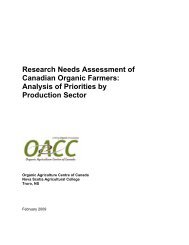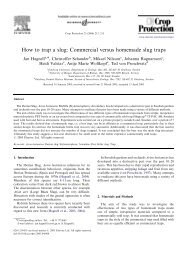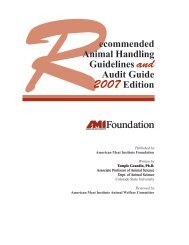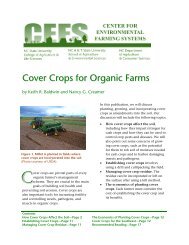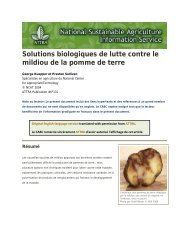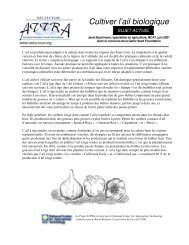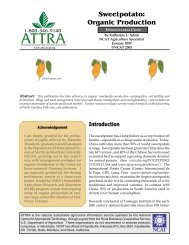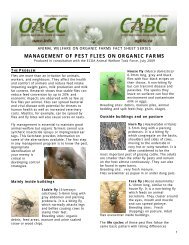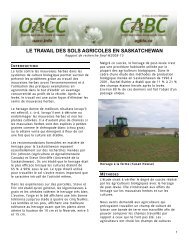You also want an ePaper? Increase the reach of your titles
YUMPU automatically turns print PDFs into web optimized ePapers that Google loves.
sequentially in rotati<strong>on</strong>s. In thispublicati<strong>on</strong>, we will discuss crop rotati<strong>on</strong>sas key strategies that farmers can use tobuild the soil, manage pests, and increaseyields. Our discussi<strong>on</strong> will be organizedaround the following topics:• A historical perspective. We willdescribe how crop rotati<strong>on</strong>s fit into thehistory of farming in America,particularly in the South, and howmodern c<strong>on</strong>venti<strong>on</strong>al farming methodshave altered the way some farmerspractice crop rotati<strong>on</strong>s.• <str<strong>on</strong>g>Crop</str<strong>on</strong>g> rotati<strong>on</strong>s versus c<strong>on</strong>tinuouscropping. We will summarize theresults of several scientific studies thathave compared the impacts of l<strong>on</strong>gandshort-term rotati<strong>on</strong>s andc<strong>on</strong>tinuous cropping, or m<strong>on</strong>oculture, <strong>on</strong>soil properties. These studies indicatethat using crop rotati<strong>on</strong>s can lead todramatic increases in soil fertility, helpto optimize nutrient and water use bycrops, and improve our soil resources.• <str<strong>on</strong>g>Crop</str<strong>on</strong>g> rotati<strong>on</strong>s and soil fertility. Wewill describe the use of crop rotati<strong>on</strong>s toimprove fertility.• <str<strong>on</strong>g>Crop</str<strong>on</strong>g> rotati<strong>on</strong>s and pest management.We will describe the use of croprotati<strong>on</strong>s to manage pests, includingdiseases, weeds, and insects.C<strong>on</strong>tinuous <str<strong>on</strong>g>Crop</str<strong>on</strong>g>pingIn the South, c<strong>on</strong>tinuous cropping thatincorporates organic matter is better thanfallow periods for the soil. During fallowperiods, biomass additi<strong>on</strong>s are not made tothe soil. However, mineralizati<strong>on</strong> of organicmatter in the soil c<strong>on</strong>tinues during fallowperiods, thus leading to reducti<strong>on</strong>s in organicmatter.A HISTORICAL PERSPECTIVEThere was a time in America when the useof l<strong>on</strong>g-term crop rotati<strong>on</strong>s figuredprominently in every farmer’s plans toboost soil fertility and c<strong>on</strong>trol crop pestsand diseases. But since the 1950s, farmersincreasingly have replaced crop rotati<strong>on</strong>swith modern practices, such as usingsynthetic fertilizers to supply annual cropnutrients, applying agri-chemicals toc<strong>on</strong>trol pests and diseases, and selectingimproved crop varieties for increased yields.Many farmers still use crop rotati<strong>on</strong>s, but inmuch shorter cycles. For instance,approximately 80 percent of the U.S. corncrop is now grown in two-year rotati<strong>on</strong>swith soybeans or three-year rotati<strong>on</strong>s withsoybeans and wheat. These short, two- tothree-year rotati<strong>on</strong>s rarely include pastures,cover crops, or green manures. Thesemodern cropping systems have allowedAmerican farmers to benefit fromec<strong>on</strong>omies of scale by specializing theiroperati<strong>on</strong>s and marketing crops in volume.And these systems require fewer pieces ofequipment because the crops grown are lessdiverse.Such modern farming practices have helpedU.S. farmers to produce remarkable cropyields. Nevertheless, the use of intensivecropping for the past 50 years has causedsome negative impacts <strong>on</strong> ourenvir<strong>on</strong>ment, especially <strong>on</strong> our farm soils.Today, the biggest risks for farmers aredeclining soil quality and increasingenvir<strong>on</strong>mental degradati<strong>on</strong>. As a result,researchers are <strong>on</strong>ce again focusing <strong>on</strong> croprotati<strong>on</strong>s as a primary way to attainsustainable crop producti<strong>on</strong>, improvedyields, and the ec<strong>on</strong>omic returns thatsupport a diversified rural ec<strong>on</strong>omy.<strong>Organic</strong> Producti<strong>on</strong>—<str<strong>on</strong>g>Crop</str<strong>on</strong>g> <str<strong>on</strong>g>Rotati<strong>on</strong>s</str<strong>on</strong>g> <strong>on</strong> <strong>Organic</strong> <strong>Farms</strong> 2



